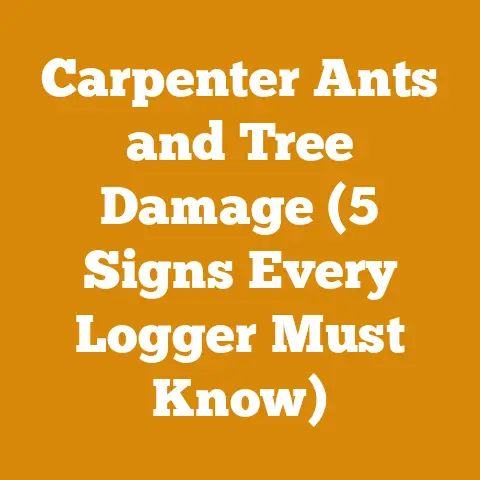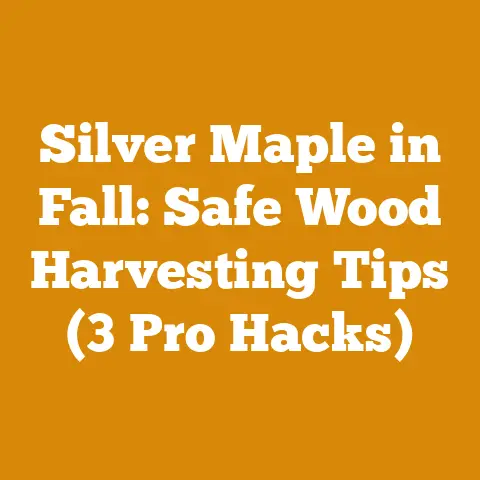How Much Does Stump Grinding Cost? (5 Pro Tips for Arborists)
As an arborist and someone deeply involved in wood processing, logging, and firewood preparation for years, I’ve seen my fair share of stumps. And let me tell you, they’re more than just unsightly reminders of trees past. They’re obstacles, potential hazards, and, frankly, a pain to deal with. But before you can even think about reclaiming that space, there’s the question of cost. “How much does stump grinding cost?” is a question I hear constantly, and the answer, unfortunately, isn’t always straightforward. Factors like the size of the stump, its location, and even the type of tree it came from can all influence the final price. Not to mention, the wear and tear on equipment like grinders, chainsaws, and even the trucks used to haul everything, adds to the overall expense.
In this guide, I’ll break down everything you need to know about stump grinding costs, sharing insider tips I’ve learned from years of experience. We’ll cover what factors affect pricing, how to get accurate estimates, and even some strategies for potentially lowering the cost. Plus, I’ll share some real-world case studies and practical advice to help you make informed decisions about stump removal. So, let’s dive in!
Why is Stump Grinding Important?
Beyond aesthetics, stump grinding offers several key benefits:
- Safety: Stumps can be tripping hazards, especially for children and the elderly. They can also obscure underground utilities, making them a danger during excavation.
- Aesthetics: Stumps are often unsightly and can detract from the overall beauty of a landscape.
- Pest Control: Decaying stumps can attract insects like termites, ants, and beetles, which can then spread to nearby structures.
- Property Value: Removing stumps can increase the value of your property by improving its appearance and usability.
- Prevents Regrowth: Some tree species are notorious for sending up suckers from their roots. Grinding the stump can help prevent this unwanted regrowth.
Factors Affecting Stump Grinding Costs
The cost of stump grinding can vary significantly depending on several factors. Understanding these factors will help you get a more accurate estimate and avoid surprises.
1. Stump Size
The size of the stump is the most significant factor affecting cost. Larger stumps require more time, effort, and machine wear to grind down. Arborists typically measure stump size by its diameter at ground level.
- Small Stumps (Under 12 inches): These are the easiest and cheapest to grind. Expect to pay anywhere from $75 to $150 per stump.
- Medium Stumps (12-24 inches): These require more time and effort. Costs typically range from $150 to $300 per stump.
- Large Stumps (24-36 inches): These can be challenging to grind, especially if they have extensive root systems. Expect to pay $300 to $500 or more per stump.
- Extra-Large Stumps (Over 36 inches): These require specialized equipment and can be very expensive to remove. Costs can easily exceed $500, and may even reach $1,000 or more.
Personal Experience: I once had a client with a massive oak stump that was over 48 inches in diameter. It took a full day of grinding with a large, commercial-grade stump grinder to remove it completely. The cost was significantly higher than a typical stump removal, but the client was thrilled with the result.
2. Stump Location and Accessibility
The location of the stump and how easily the stump grinder can access it also play a significant role in pricing.
- Easy Access: Stumps located in open areas with easy access for the grinder will be cheaper to remove.
- Difficult Access: Stumps located in tight spaces, on steep slopes, or behind fences will be more expensive. Arborists may need to use smaller, more maneuverable grinders, which can take longer. They may also need to spend extra time preparing the site.
Case Study: I remember a job where a customer wanted a stump ground down that was located in their back yard, behind a narrow gate. I had to use a compact stump grinder, and it took nearly twice as long to complete the job compared to a similar-sized stump in an open area. The added time and effort increased the overall cost.
3. Stump Quantity
Many arborists offer discounts for removing multiple stumps at once. This is because the setup and travel costs are spread across multiple jobs, making it more efficient.
- Single Stump: Expect to pay a higher price per stump for single stump removals.
- Multiple Stumps: Ask for a discounted rate if you have multiple stumps that need grinding.
4. Stump Type
The type of tree can also affect the cost of stump grinding. Hardwood stumps, such as oak or maple, are more difficult to grind than softwood stumps, such as pine or fir. This is because hardwoods are denser and more resistant to the cutting wheel.
- Softwood Stumps: Easier and cheaper to grind.
- Hardwood Stumps: More difficult and expensive to grind.
Data Insight: In my experience, grinding a 24-inch oak stump can take up to 50% longer than grinding a 24-inch pine stump. This difference in time directly translates to higher labor costs.
5. Root System
The extent of the root system can also impact the cost of stump grinding. Stumps with large, sprawling root systems require more extensive grinding to ensure complete removal.
- Shallow Root Systems: Easier and cheaper to grind.
- Deep, Sprawling Root Systems: More difficult and expensive to grind.
Technical Detail: Some arborists use ground-penetrating radar (GPR) to map out the root system before grinding. This allows them to provide a more accurate estimate and avoid surprises during the grinding process.
6. Travel Time and Distance
Arborists typically charge for travel time and distance, especially if they have to travel a significant distance to reach your property.
- Local Arborists: Choose a local arborist to minimize travel costs.
- Out-of-Area Arborists: Be prepared to pay extra for travel time and mileage.
7. Additional Services
Some arborists offer additional services, such as stump removal (digging out the entire stump and root system), soil removal, and replanting. These services will add to the overall cost.
- Stump Removal: This is a more labor-intensive process than stump grinding and will be more expensive.
- Soil Removal: Removing the soil contaminated with wood chips can add to the cost.
- Replanting: If you want to replant grass or shrubs in the area, this will also add to the cost.
8. Local Market Rates
Stump grinding costs can vary depending on the local market rates in your area. Prices may be higher in urban areas with a higher cost of living.
- Research Local Rates: Get quotes from multiple arborists in your area to get a sense of the average cost.
- Consider Location: Be aware that prices may be higher in urban areas.
Stump Grinding Cost Calculation Methods
Arborists use various methods to calculate stump grinding costs. Understanding these methods will help you negotiate a fair price.
1. Per-Stump Pricing
This is the most common method, where the arborist charges a flat rate for each stump. The price is typically based on the size and type of the stump.
Example: An arborist might charge $100 for a small stump (under 12 inches), $200 for a medium stump (12-24 inches), and $300 for a large stump (24-36 inches).
2. Hourly Rate
Some arborists charge an hourly rate for stump grinding. This method is more common for complex jobs or when the exact time required is difficult to estimate.
Example: An arborist might charge $75 to $150 per hour for stump grinding.
3. Diameter-Based Pricing
This method charges a per-inch rate based on the stump’s diameter at ground level.
Example: An arborist might charge $5 to $10 per inch of stump diameter. A 20-inch stump would cost $100 to $200.
4. Minimum Charge
Many arborists have a minimum charge for stump grinding services. This is to cover their travel time and setup costs.
Example: An arborist might have a minimum charge of $100, even if the stump is very small.
5 Pro Tips for Arborists for Accurate Estimates
As an arborist myself, I know the importance of providing accurate estimates to clients. Here are five pro tips I use to ensure my estimates are fair and transparent:
1. Thorough Site Inspection
Always conduct a thorough site inspection before providing an estimate. This includes:
- Measuring the stump diameter: Use a measuring tape to accurately measure the stump’s diameter at ground level.
- Assessing the stump location and accessibility: Note any obstacles that might make the job more difficult.
- Identifying the tree type: Knowing the tree type will help you estimate the grinding time.
- Examining the root system: Look for any signs of extensive or deep roots.
- Checking for underground utilities: Always call 811 (Call Before You Dig) to locate any underground utilities before starting work.
Personal Story: I once underestimated the cost of a stump grinding job because I didn’t realize the stump was located near a gas line. Fortunately, I called 811 before starting work and was able to avoid a potentially dangerous situation. The extra time and effort required to work around the gas line significantly increased the cost of the job.
2. Use a Stump Grinding Cost Calculator
There are many online stump grinding cost calculators that can help you estimate the cost of a job. These calculators typically take into account factors such as stump size, location, and tree type.
Tool Specification: I personally use the “Stump Grinding Cost Calculator” on Fixr.com. It’s a reliable tool that provides a good starting point for estimating costs.
3. Factor in All Costs
Make sure to factor in all costs when providing an estimate, including:
- Labor Costs: Calculate the hourly rate for yourself and any employees.
- Equipment Costs: Include the cost of renting or owning the stump grinder, as well as fuel and maintenance costs.
- Travel Costs: Factor in travel time and mileage.
- Disposal Costs: Include the cost of disposing of the wood chips.
- Insurance Costs: Make sure you have adequate insurance coverage.
- Overhead Costs: Factor in your general business expenses, such as rent, utilities, and marketing.
Data Analysis: I track all my costs using accounting software. This allows me to see exactly how much each job costs and adjust my pricing accordingly.
4. Provide a Detailed Written Estimate
Always provide a detailed written estimate to your clients. The estimate should include:
- A description of the work to be performed: Clearly outline what you will do.
- The cost of the work: Provide a breakdown of the costs, including labor, equipment, travel, and disposal.
- The payment terms: Specify when payment is due and what forms of payment you accept.
- Your contact information: Include your name, phone number, and email address.
- Your insurance information: Provide proof of insurance.
Legal Advice: Consult with an attorney to ensure your estimate is legally binding and protects your interests.
5. Be Transparent and Honest
Always be transparent and honest with your clients about the cost of stump grinding. Explain the factors that affect pricing and be willing to answer any questions they may have.
Ethical Consideration: I always tell my clients that the final cost may vary slightly depending on the actual time required to complete the job. However, I also assure them that I will never exceed the estimated cost without their approval.
How to Save Money on Stump Grinding
If you’re looking to save money on stump grinding, here are a few tips:
1. Get Multiple Quotes
Get quotes from at least three different arborists to compare prices. Be sure to ask for a detailed written estimate so you can compare apples to apples.
2. Do Some of the Work Yourself
You can save money by doing some of the work yourself, such as clearing the area around the stump and disposing of the wood chips.
3. Grind Multiple Stumps at Once
If you have multiple stumps that need grinding, ask for a discounted rate.
4. Choose the Right Time of Year
Stump grinding is often cheaper during the off-season (fall and winter) when arborists are less busy.
5. Consider Renting a Stump Grinder
If you’re comfortable operating heavy machinery, you can rent a stump grinder and do the work yourself. However, be sure to follow all safety precautions and wear appropriate protective gear.
Safety Precaution: Always wear safety glasses, hearing protection, and gloves when operating a stump grinder.
DIY Stump Grinding vs. Hiring a Professional
Deciding whether to grind a stump yourself or hire a professional is a crucial decision. Here’s a breakdown of the pros and cons of each option:
DIY Stump Grinding
Pros:
- Cost Savings: Renting a stump grinder can be cheaper than hiring a professional, especially for small stumps.
- Flexibility: You can grind the stump at your own pace and on your own schedule.
- Control: You have complete control over the process.
Cons:
- Safety Risks: Stump grinders are powerful machines that can cause serious injury if not operated properly.
- Physical Labor: Stump grinding is physically demanding work.
- Time Commitment: It can take several hours to grind a single stump, especially if you’re not experienced.
- Equipment Costs: Renting a stump grinder can be expensive, and you may also need to purchase safety gear.
- Potential Damage: You could damage your property or underground utilities if you’re not careful.
Hiring a Professional
Pros:
- Safety: Professionals have the experience and training to operate stump grinders safely.
- Efficiency: Professionals can grind stumps quickly and efficiently.
- Convenience: You don’t have to do any of the work yourself.
- Insurance: Professionals are insured in case of accidents or damage.
- Expertise: Professionals can assess the stump and root system and recommend the best course of action.
Cons:
- Higher Cost: Hiring a professional is more expensive than renting a stump grinder.
- Scheduling: You may have to wait for a professional to become available.
- Less Control: You have less control over the process.
Recommendation: I generally recommend hiring a professional for stump grinding, especially if you’re not experienced with heavy machinery or if the stump is large or difficult to access. The safety risks and potential for damage are simply too great to justify the cost savings.
Stump Grinding and Firewood Preparation
You might be wondering, what does stump grinding have to do with firewood preparation? Well, the wood chips produced by stump grinding can actually be used as a valuable resource for firewood preparation.
1. Wood Chip Mulch
The wood chips can be used as mulch around trees and shrubs, helping to retain moisture and suppress weeds.
Wood Type Selection: Hardwood chips, such as oak or maple, are ideal for mulch because they decompose slowly and provide long-lasting benefits.
2. Compost
The wood chips can be added to your compost pile, providing a source of carbon and helping to improve the overall quality of the compost.
Drying Methods: Allow the wood chips to dry out before adding them to your compost pile. This will help to prevent the compost from becoming too wet and anaerobic.
3. Firewood Kindling
Small wood chips can be used as kindling to start fires.
Tool Specifications: Use a hatchet or small axe to split larger wood chips into smaller pieces for kindling.
4. Wood-Fired Heating
In some cases, the wood chips can be used as fuel for wood-fired heating systems.
Moisture Content Targets: Ensure the wood chips are properly dried before using them as fuel. The ideal moisture content is below 20%.
Conclusion: Making Informed Decisions About Stump Grinding
Stump grinding is an important part of maintaining a safe and attractive landscape. By understanding the factors that affect stump grinding costs and following the tips outlined in this guide, you can make informed decisions about stump removal and ensure you get a fair price. Whether you choose to hire a professional or tackle the job yourself, remember to prioritize safety and take the necessary precautions to protect yourself and your property.
Next Steps:
- Assess Your Needs: Determine the number, size, and location of the stumps you need to remove.
- Get Multiple Quotes: Contact at least three different arborists for estimates.
- Compare Prices and Services: Carefully compare the quotes and services offered by each arborist.
- Check References and Insurance: Verify the arborist’s references and insurance coverage.
- Make an Informed Decision: Choose the arborist that best meets your needs and budget.
- Schedule the Work: Schedule the stump grinding work at a time that is convenient for you.
- Prepare the Site: Clear the area around the stumps and mark any underground utilities.
- Supervise the Work: Monitor the stump grinding process to ensure it is done safely and properly.
- Clean Up the Site: Dispose of the wood chips and fill the hole with soil.
- Enjoy Your Stump-Free Landscape: Replant grass or shrubs in the area and enjoy your newly reclaimed space.






